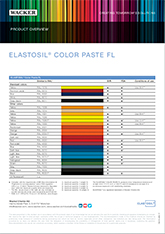
Moldmaking with Silicones: Quick Guides for Better Results
Welcome to the Moldmaking Laboratory. Our experts have recorded short videos that deal with typical questions. These quick guides are just a few minutes long and show how you can easily achieve even better results when using ELASTOSIL® M.
Addition-curing ELASTOSIL® M products combine extremely accurate details with maximum dimensional stability. They do not shrink on curing, as shown in this video.
Condensation-curing ELASTOSIL® M products shrink by 0.2 – 0.8% during curing. While a faithful reproduction, the mold is not 100% dimensionally accurate.
The video shows clearly how addition-curing silicone rubber grades differ from their condensation-curing counterparts in terms of shrinkage (duration: approx. 2 minutes).
You’ll find basic information in our article: “ Moldmaking and Prototyping: Here’s How to Find the Right Moldmaking Compound”
Addition-curing ELASTOSIL® M products don’t shrink and are therefore extremely accurate. But curing can be inhibited by a variety of ambient substances. If you find the mold cures inadequately or not at all, check the surrounding area for the following substances in particular:
- Sulfur and sulfur-containing materials, such as EPDM, amines or urethanes
- Amine-containing materials, such as PU and amine-cured epoxy resins
- Organometallic or organotin substances
- Tin-based catalysts for condensation-curing silicone rubber compounds
Sometimes it is enough not to wear latex gloves and to ensure that the surrounding area is very clean.
The video shows the effects of inhibition (duration: approx. 2:30 minutes).
Antistatic ELASTOSIL® RT products stop dust from accumulating on the silicone pad and avoid splatters or droplets of paint that might otherwise be produced as a result of electrostatic charging.
The video shows the difference between standard silicone rubbers and antistatic ELASTOSIL® RT grades (duration: approx. 1:30 minutes).
For more information on ELASTOSIL® products for pad printing, visit our product page or read the flyer.
ELASTOSIL® M products enjoy excellent self-deaerating properties. In typical standard applications, these materials produce bubble-free results without requiring further measures.
It is advisable to use a vacuum pump whenever your work involves skin molds, closed molds or relatively high-viscosity silicone rubber compounds.
The video shows the self-deaerating properties of ELASTOSIL® M and the correct use of a vacuum pump (duration: approx. 5 minutes).
All ELASTOSIL® M products can be colored using ELASTOSIL® pigment pastes. Translucent grades make it easier to obtain color-fast results based on tailored color scales. Food-grade colors are available.
The video shows how easy it is to customize the coloring of ELASTOSIL® M silicone rubber compounds (duration: approx. 2 minutes).
For further information, visit our product page or read our flyer.
The flexibility and mechanical strength of standard ELASTOSIL® M products ensures sufficient mold release for typical applications.
But if the articles to be molded incorporate undercuts or sharp edges, you should choose products with increased tear strength. Excellent mechanical properties are likewise beneficial if you are planning to make a large number of copies.
The video shows the benefits of different mechanical properties (duration: approx. 2 minutes).
Free-flowing addition-curing ELASTOSIL® M products easily become spreadable and non-sag grades thanks to the addition of WACKER Stabilizer 43.
In the case of condensation-curing ELASTOSIL® M products, use WACKER Thixotropic Agent C.
The video shows how easy it is to customize the thixotropy of ELASTOSIL® M products (duration: approx. 2 minutes).
You will find other useful information about processing, selection and troubleshooting in our interactive PDF (see downloads), in other articles (see “Related Articles”) and in the product portal under “Moldmaking and Prototype Molding”.
You will find further articles on the topic of moldmaking with ELASTOSIL® M using the “Moldmaking and Prototype Molding” tag.





